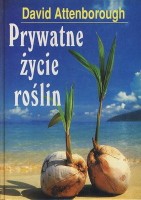 Tytuł: Prywatne życie roślin
Tytuł: Prywatne życie roślin
Tytuł oryginału: The Private Life of Plants
Autor(zy): David Attenborough,
Tłumaczenie: Justyna Jannasz
Rok wydania: 1994 (ENG), 1996 (PL)
Wydawnictwo: BBC Books, Świat Książki
Dlaczego w bazie: Ksiązkowa wersja programu przyrodniczego który mamy już opisany w bazie. Żółwie pojawiają się w tej książce w trzech miejscach:
Pierwsza wzmianka jest niebezpośrednia, wspominany jest „small tortoiseshell butterfly”, gdzie oczywiście środkowy człon można rozumieć jako „szylkretowy”. Internet podpowiada jednakże, że polska nazwa tego motyla to „Rusałka pokrzywnik”.
The caterpillars of small tortoiseshell and red admiral butterflies chew their way around the dangerous needles and the succulent leaves of nettles, so shunned by other bigger animals, are one of their favourite foods.
Druga wzmianka jest nawiązanie do historii Żółwia i Zająca. Wyjaśnione jest, że Dęby rosną wolniej niż Brzozy, ale z każdym rokiem są większe i silniejsze i w końcu zaczynają rywalizować o zasoby z brzozami. Użyte zostaje właśnie porównanie, że w tym wyścigu Żółw zaczyna się równać z Zającem.
The young oaks grow slowly. The demands they make on the soil are less than those of the swift-growing birch. But each year they are bigger and stronger and eventually the time comes when they begin to rival the birches. In this long race, the tortoise is beginning to catch up with the hare.
Kolejna wzmianka jest we fragmencie o „pebble plants”, litopach, tym jak ich wygląd daje im szansę na uniknięcie zjedzenia przez zwierzęta, np. żółwie.
Outside the flowering season, the plant is very difficult to find among the gravel and pebbles, so its shape could also serve as a devence against detection by grazing animals – ostrichces and tortoises, porcupines and perhaps a few gerbils.

Autor: XYuriTT
